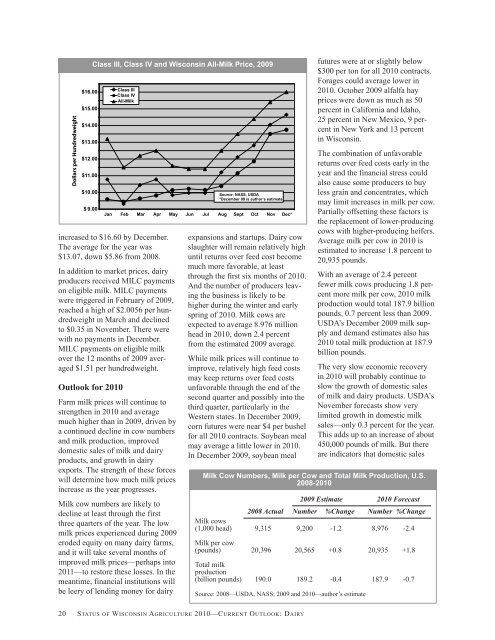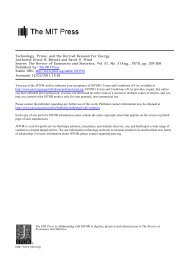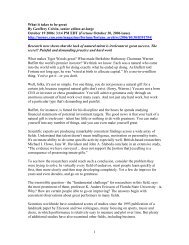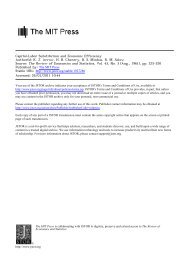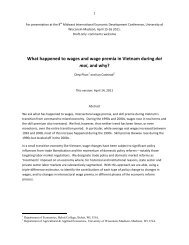Status of Wisconsin Agriculture 2010 - Agricultural & Applied ...
Status of Wisconsin Agriculture 2010 - Agricultural & Applied ...
Status of Wisconsin Agriculture 2010 - Agricultural & Applied ...
Create successful ePaper yourself
Turn your PDF publications into a flip-book with our unique Google optimized e-Paper software.
Dollars per Hundredweight<br />
$16.00<br />
$15.00<br />
$14.00<br />
$13.00<br />
$12.00<br />
$11.00<br />
$10.00<br />
$ 9.00<br />
increased to $16.60 by December.<br />
The average for the year was<br />
$13.07, down $5.86 from 2008.<br />
In addition to market prices, dairy<br />
producers received MILC payments<br />
on eligible milk. MILC payments<br />
were triggered in February <strong>of</strong> 2009,<br />
reached a high <strong>of</strong> $2.0056 per hundredweight<br />
in March and declined<br />
to $0.35 in November. There were<br />
with no payments in December.<br />
MILC payments on eligible milk<br />
over the 12 months <strong>of</strong> 2009 averaged<br />
$1.51 per hundredweight.<br />
Outlook for <strong>2010</strong><br />
Class III, Class IV and <strong>Wisconsin</strong> All-Milk Price, 2009<br />
Class III<br />
Class IV<br />
All-Milk<br />
Jan Feb Mar Apr May Jun Jul Aug Sept Oct Nov Dec*<br />
Farm milk prices will continue to<br />
strengthen in <strong>2010</strong> and average<br />
much higher than in 2009, driven by<br />
a continued decline in cow numbers<br />
and milk production, improved<br />
domestic sales <strong>of</strong> milk and dairy<br />
products, and growth in dairy<br />
exports. The strength <strong>of</strong> these forces<br />
will determine how much milk prices<br />
increase as the year progresses.<br />
Milk cow numbers are likely to<br />
decline at least through the first<br />
three quarters <strong>of</strong> the year. The low<br />
milk prices experienced during 2009<br />
eroded equity on many dairy farms,<br />
and it will take several months <strong>of</strong><br />
improved milk prices—perhaps into<br />
2011—to restore these losses. In the<br />
meantime, financial institutions will<br />
be leery <strong>of</strong> lending money for dairy<br />
Source: NASS, USDA<br />
*December 09 is author’s estimate<br />
expansions and startups. Dairy cow<br />
slaughter will remain relatively high<br />
until returns over feed cost become<br />
much more favorable, at least<br />
through the first six months <strong>of</strong> <strong>2010</strong>.<br />
And the number <strong>of</strong> producers leaving<br />
the business is likely to be<br />
higher during the winter and early<br />
spring <strong>of</strong> <strong>2010</strong>. Milk cows are<br />
expected to average 8.976 million<br />
head in <strong>2010</strong>, down 2.4 percent<br />
from the estimated 2009 average.<br />
While milk prices will continue to<br />
improve, relatively high feed costs<br />
may keep returns over feed costs<br />
unfavorable through the end <strong>of</strong> the<br />
second quarter and possibly into the<br />
third quarter, particularly in the<br />
Western states. In December 2009,<br />
corn futures were near $4 per bushel<br />
for all <strong>2010</strong> contracts. Soybean meal<br />
may average a little lower in <strong>2010</strong>.<br />
In December 2009, soybean meal<br />
futures were at or slightly below<br />
$300 per ton for all <strong>2010</strong> contracts.<br />
Forages could average lower in<br />
<strong>2010</strong>. October 2009 alfalfa hay<br />
prices were down as much as 50<br />
percent in California and Idaho,<br />
25 percent in New Mexico, 9 percent<br />
in New York and 13 percent<br />
in <strong>Wisconsin</strong>.<br />
The combination <strong>of</strong> unfavorable<br />
returns over feed costs early in the<br />
year and the financial stress could<br />
also cause some producers to buy<br />
less grain and concentrates, which<br />
may limit increases in milk per cow.<br />
Partially <strong>of</strong>fsetting these factors is<br />
the replacement <strong>of</strong> lower-producing<br />
cows with higher-producing heifers.<br />
Average milk per cow in <strong>2010</strong> is<br />
estimated to increase 1.8 percent to<br />
20,935 pounds.<br />
With an average <strong>of</strong> 2.4 percent<br />
fewer milk cows producing 1.8 percent<br />
more milk per cow, <strong>2010</strong> milk<br />
production would total 187.9 billion<br />
pounds, 0.7 percent less than 2009.<br />
USDA’s December 2009 milk supply<br />
and demand estimates also has<br />
<strong>2010</strong> total milk production at 187.9<br />
billion pounds.<br />
The very slow economic recovery<br />
in <strong>2010</strong> will probably continue to<br />
slow the growth <strong>of</strong> domestic sales<br />
<strong>of</strong> milk and dairy products. USDA’s<br />
November forecasts show very<br />
limited growth in domestic milk<br />
sales—only 0.3 percent for the year.<br />
This adds up to an increase <strong>of</strong> about<br />
450,000 pounds <strong>of</strong> milk. But there<br />
are indicators that domestic sales<br />
Milk Cow Numbers, Milk per Cow and Total Milk Production, U.S.<br />
2008-<strong>2010</strong><br />
2009 Estimate <strong>2010</strong> Forecast<br />
2008 Actual Number %Change Number %Change<br />
Milk cows<br />
(1,000 head) 9,315 9,200 -1.2 8,976 -2.4<br />
Milk per cow<br />
(pounds) 20,396 20,565 +0.8 20,935 +1.8<br />
Total milk<br />
production<br />
(billion pounds) 190.0 189.2 -0.4 187.9 -0.7<br />
Source: 2008—USDA, NASS; 2009 and <strong>2010</strong>—author’s estimate<br />
20 STATUS OF WISCONSIN AGRICULTURE <strong>2010</strong>—CURRENT OUTLOOK: DAIRY


